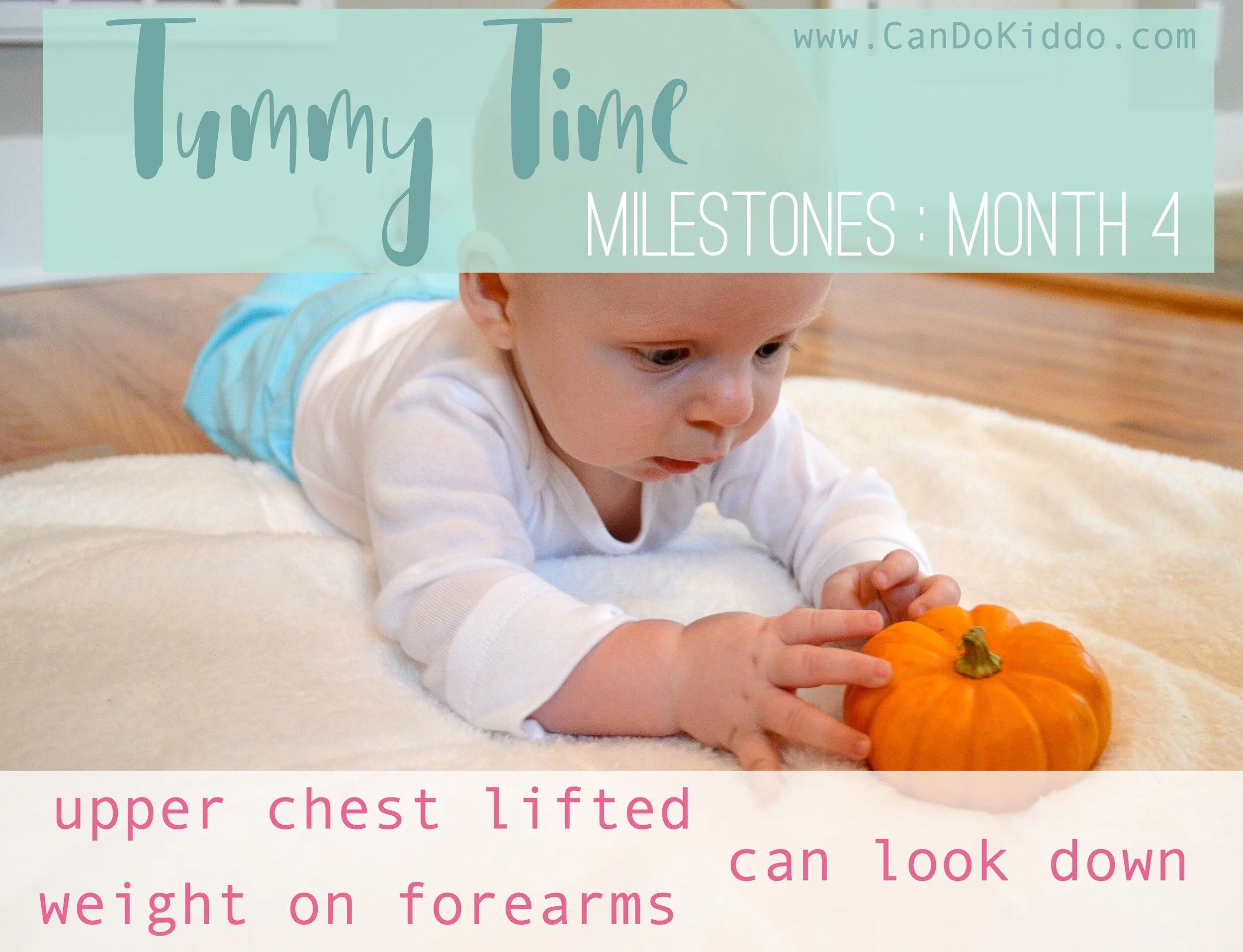Tummy Time Milestones For Babies
You may have heard how important tummy time is for your baby's development. Perhaps you’re also one of many parents who only hear that tummy time is about your little one lifting their head to gain neck strength.
Because I'm a huge child development nerd (and pediatric occupational therapist), I love sharing a glimpse of what's really going on with babies during tummy time. When I discovered The Play Kits by Lovevery, it was clear the company shared my passion for helping parents discover a world of skills they can encourage their baby to develop through play—skills they otherwise would have missed.
Understanding your baby's milestones in tummy time can help you more confidently and creatively play in ways that match your little one’s unfolding abilities. These subtle signs can also give you more awareness of your baby’s individual developmental track.
Important: The ages listed are general averages. Your baby may achieve these milestones a month or two ahead or behind the ages listed here and that’s okay! The goal of parenting your baby isn’t to fit perfectly into developmental norms. It’s to discover, support, and celebrate your baby’s individual developmental journey. Look for a trend of progress and discuss any specific developmental concerns with your child's doctor. Parents of preemies can also adjust age to account for their baby’s early arrival.
The First Days:
You may notice your baby:
Remain cheek down for majority of tummy time
Lift and turn their head briefly with great effort
Keep their arms bent with their hands near their shoulders
Keep their knees bent and under hips (booty in the air)
Make "crawling" or "pushing" motions with the feet
You don’t need to delay tummy time until their umbilical stump falls off unless otherwise advised by your child's pediatrician.
Child development nerd tidbit: Starting tummy time in the first week of life for healthy, full-term infants can improve tummy time tolerance down the road. You might be surprised that most newborns tolerate this natural position very well, especially on a caregiver’s body. Even when they’re not lifting their head, early tummy time is very important and beneficial.
Play idea: I love standing books up for visual exploration for newborns. Lovevery’s Standing Card Holder makes it easy to swap simple and more complex black-and-white cards to capture your baby’s attention at this age.
The First Few Months:
You may notice your baby:
Briefly lift their head (usually bobbing, not still) to about 45 degrees
Turn their head to place opposite cheek down
Become comfortable with either cheek down
Begin to straighten their legs during tummy time so their lower belly touches the surface beneath them
Place their arms further away from their body during tummy time
Begin to press hands down into the surface to push their shoulders and very top of their chest up very slightly off the surface beneath
WATCH: Lovevery app Expert Video - OT Rachel Coley demonstrates infant play in modified Tummy Time position
Child development nerd tidbit: Lifting their head with it turned to one side shows your baby is using the muscles of one side of their neck. As the brain-body connection develops in the first few months, you may notice them using both sides of their neck at the same time to lift and hold their head steady during tummy time. It looks like they just got stronger, but actually this is one of the first times they’re practicing using the two sides of their body together in a coordinated way! Be sure to discuss with your doctor if you notice your baby only looking one direction in tummy time, which may be an indication of tightness or weakness on one side of the neck (called Torticollis).
After the relative ease of cheek-down tummy time in the first few weeks of life, these early months of tummy time can be the toughest for your little one to tolerate.
Play idea: Try placing high-contrast toys to the side rather than just in front of your baby during tummy time. Otherwise, they likely won’t see them! In The Lovevery App for Play Kit Subscribers, I share videos of tummy time modifications and creative ways to play.
Tummy Time Around 3 Months
You may notice your baby:
Lift their head 45-90 degrees and hold it without bobbing
Turn to look both directions with head lifted
Place their elbows under or in front of their shoulders
Occasionally lift their shoulders and the very top of their chest off a surface by pressing weight into their forearms
Accidentally roll belly to side if they turn their head too far
Child development nerd tidbit: What began as reflexive head turning to clear the airway and seek out food (the rooting reflex) has now become intentional head turning to look or hear, depending on your baby’s preferred or available senses. All that head turning and lifting is helping your little one develop and connect the movement (vestibular), vision, and auditory sensory systems. Sensory integration skills start in infancy!
Play idea: A great way to build endurance for sustained head lifting in tummy time is with a baby-safe, clear mirror. I had a lot of trouble finding one and was so glad to discover Lovevery’s Framed Mirror. Prop it up, get on your belly with them, and chat away with that baby in the mirror.
Tummy Time Around 4 Months
You may notice your baby:
Lift and hold their head steady to 90 degrees
Press through their forearms to lift their upper chest
Keep their chest lifted while looking down at their hands
Lift their arms and legs off the floor and rock or appear to be "swimming" or "flying"
Child development nerd tidbit: It seems to make no sense that your baby assumes the "swimming" or "flying" position when they see a toy in front of them that they want. But rest assured, alternating between two different movements—this one and propping themselves up with their forearms—is an indication of motor coordination and a sign they may be gearing up to crawl in coming months.
Play idea: Around this age, your kiddo is likely starting to reach and grasp in tummy time, and doing lots of tactile exploration with their hands and mouth. I like to encourage this using the Rolling Bell and Crinkle Bag from Lovevery’s Charmer Play Kit. These simple toys intrigue babies without overstimulating them with flashing lights or electronic sounds.
Tummy Time Around 5 Months
You may notice your baby:
Get active during tummy time
Reaches for objects
Roll intentionally from belly to sidelying
Lift their chest off a surface as they press through straight arms
Child development nerd tidbit: If your baby is able to repeatedly roll out of tummy time, you'll likely see shorter periods of belly-down play. Offering plenty of floor time play (outside of baby holding devices) is still essential, as it allows your baby to practice new skills and develop new ones.
Play idea: One of my biggest tummy time tips is novelty. And I’ve never met a baby who isn’t enamored with the Lovevery Magic Tissue Box (even the tummy time “haters”). As your baby gets older, they’ll go from watching you pull tissues to learning how to empty the box themselves.
Tummy Time Around 6 to 7 Months
You may notice your baby:
Reach with one arm
Push backward on their belly using arms
Begin to assume push-up position with their belly off floor
Use their arms to semi-circle pivot on their belly
Press through hands
Become comfortable with their palms on floor (hands aren’t fisted)
Child development nerd tidbit: Tummy time is important for hand development. When your little one presses down through open hands, they’re stretching and strengthening their finger muscles.
Play idea: Placing toys in a semi-circle around your baby can encourage your baby to pivot and practice other pre-crawling skills. I like to use the Nesting Stacking Dripdrop Cups for this because there are plenty to spread around and babies love to mouth them.
Does Your Baby Still Need Tummy Time?
At some point, most babies graduate from the tummy time position. It becomes a transitional position—meaning they'll only move into and out of it briefly on their way to other positions and movements, like getting onto their hands and knees, rolling, and pushing up to sit. In general, my recommendation is to continue to give your little one plenty of unrestricted daily floor time play, but don't stress about tummy time.
In some cases, I do recommend parents continue to help their baby have daily tummy time. These include:
To help strengthen neck muscles (as in the case of Torticollis or babies with low muscle tone)
If your baby is resistant to bearing weight through their arms and hands
If your little one has not yet achieved the tummy time milestones of lifting their chest off the floor and pressing through their hands (as opposed to just the forearms)
If your baby has a flat spot on their head that they prefer to roll to when unrestricted for floor time play
As your little one grows, it’s essential to keep supporting their brain development—well beyond tummy time. That’s why I’ll always recommend The Play Kits by Lovevery. Each box has everything you need as they practice new skills and learn new ones through play they naturally love.







